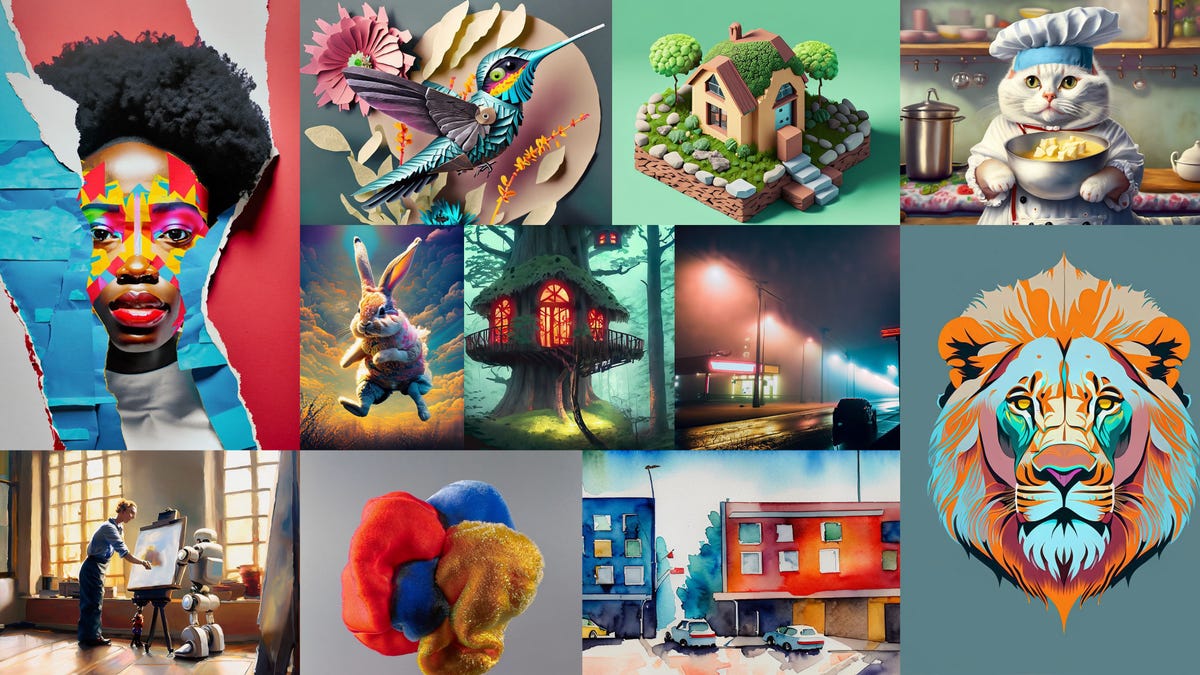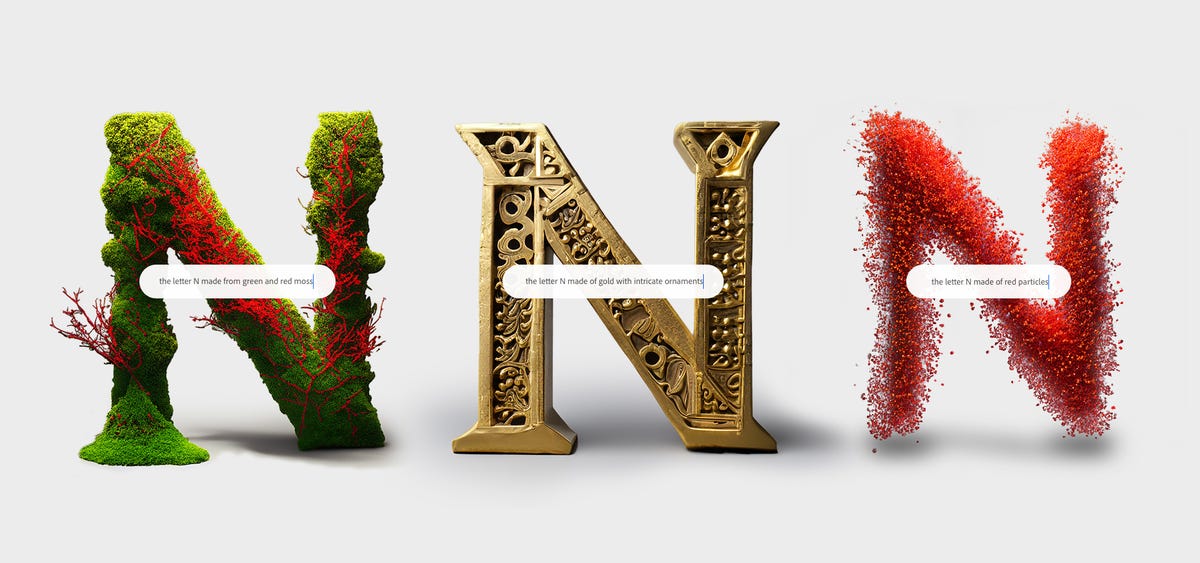Technologies
Adobe: Our New Generative AI Will Help Creative Pros, Not Hurt Them
The Firefly tools begin with image creation and font styling but soon will spread to Photoshop and other software.

In 2022, OpenAI’s Dall-E service wowed the world with the ability to turn text prompts into images. Now Adobe has built its own version of this generative AI technology with tools that begin a technological overhaul of the company’s widely used creative tools.
On Tuesday, Adobe released the first two members of its new Firefly collection of generative AI tools for beta testing. The first tool creates an image based on a text prompt like «fierce alligator leaping out of the water during a lightning storm,» with hundreds of styles that can tweak results. The other applies prompt-based styles to text, letting people create letters that look hairy, scaly, mossy or however else they want.
Firefly for now is available on Adobe’s website, but the company will build generative AI directly into other tools, starting with its Photoshop image editing software, Illustrator for designs and Adobe Express for creating quick videos. The company hasn’t revealed its pricing approach for the new tools.
Creative professionals might see Firefly as an incursion into their creative domain, going beyond mechanical tools like selecting colors and trimming videos into the heart and soul of their jobs. With AI showing new smarts when it comes to translating documents, interpreting tax code, composing music and creating travel itineraries, it’s not irrational for professionals to feel spooked.
Like other AI fans, though, Adobe sees artificial intelligence as the latest digital tool to amplify what humans can do. For example, Firefly eventually could let people use Adobe tools to tailor designs to individuals instead of just creating one design for a broad audience, said Alexandru Costin, vice president of Adobe’s generative AI work.
«We don’t think AI will replace creative creators. We think that creators using AI will be more competitive than creators not using AI. This is why we want to bring AI to the fingertips of all our user base,» Costin said. «The only way to succeed in AI is to embrace it.»
Adobe’s Firefly products are trained from the company’s own library of stock images, along with public domain and licensed works. The company has worked to reduce the bias in training data that AI models can reflect, for example that business executives are male.
AI is a «sea change»
Artificial intelligence uses processes inspired by human brains for computing tasks, trained to recognize patterns in complex real-world data instead of following traditional and rigid if-this-then-that programming. With advances in AI hardware, software, algorithms and training data, the field is advancing rapidly and touching just about every corner of tech.
The latest flavor of the technology, generative AI, can create new material on its own. The best known example, ChatGPT, can write software, hold conversations and compose poetry. Microsoft is employing ChatGPT’s technology foundation, GPT-4, to boost Bing search results, offer email writing tips and help build presentations
AI tools are sprouting up all over. Adobe has used AI for years under its Sensei brand for features like recognizing human subjects in Lightroom photos and transcribing speech into text in Premiere Pro videos. EbSynth applies a photo’s style to a video, HueMint creates color palettes and LeiaPix converts 2D photos into 3D scenes.
But it’s the new generative AI that brings new creative possibilities to digital art and design.
«It’s a sea change,» said Forrester analyst David Truog.


One of the first members of Adobe’s Firefly family of generative AI tools will style text based on prompts like «the letter N made of gold with intricate ornaments.»
AdobeAlpaca offers a Photoshop plug-in to generate art, and Aug X Labs can turn a text prompt into a video. Google’s MusicLM converts text to music, though it’s not open to the public. Dall-E captured the internet’s attention with its often fantastical imagery — the name marries Pixar’s WALL-E robot with the surrealist painter Salvador Dalí.
Related tools like Midjourney and Stability AI’s Stable Diffusion spread the technology even further.
If Adobe didn’t offer generative AI abilities, creative pros and artists would get them from somewhere else.
Indeed, Microsoft on Tuesday incorporated Dall-E technology with its Bing Image Creator service.
Training AIs isn’t easy, but it’s getting less difficult, at least for those who have a healthy budget. Chip designer Nvidia on Tuesday announced that Adobe is using its new H100 Hopper GPU to train Firefly models through a new service called Picasso. Other Picasso customers include photo licensing companies Getty Images and Shutterstock.
Legal engineering
Developing good AI isn’t just a technical matter. Adobe set up Firefly to sidestep legal and social problems that AI poses.
For example, three artists sued Stability AI and Midjourney in January over the use of their works in AI training data. They «seek to end this blatant and enormous infringement of their rights before their professions are eliminated by a computer program powered entirely by their hard work,» their lawsuit said.
Getty Images also sued Stability AI, alleging that it «unlawfully copied and processed millions of images protected by copyright.» It offers licenses to its enormous catalog of photos and other images for AI training, but Stability AI didn’t license the images. Stability AI, DeviantArt and Midjourney didn’t respond to requests for comment.
Adobe wants to assure artists that they needn’t worry about such problems. There are no copyright problems, no brand logos, and no Mickey Mouse characters. «You don’t want to infringe somebody else’s copyright by mistake,» Costin said.
The approach is smart, Truog said.
«What Adobe is doing with Firefly is strategically very similar to what Apple did by introducing the iTunes Music Store 20 years ago,» he said. Back then, Napster music sharing showed demand for online music, but the recording industry lawsuits crushed the idea. «Apple jumped in and designed a service that let people access music online but legally, more easily, and in a way that compensated the content creators instead of just stealing from them.»
Adobe also worked to counteract another problem that could make businesses leery, showing biased or stereotypical imagery.
It’s now up to Adobe to convince creative pros that it’s time to catch the AI wave.
«The introduction of digital creativity has increased the number of creative jobs, not decreased them, even if at the time it looked like a big threat,» Costin said. «We think the same thing will happen with generative AI.»
Editors’ note: CNET is using an AI engine to create some personal finance explainers that are edited and fact-checked by our editors. For more, see this post.
Technologies
Give the Gift of Great Sound With Sennheiser Headphones at a 60% Black Friday Discount
The Sennheiser Momentum 4 headphones are now down to a record low price of $179 this Black Friday.

Spending this Black Friday shopping for a holiday gift for an audiophile? With tons of items on sale, there are plenty to chose from. Sennheiser is behind some of the best wireless headphones you can buy, but its headphones can be prohibitively costly.
But for two days only, Woot is running a Black Friday deal that brings the Sennheiser Momentum 4 headphones down to $179 from the original $450 price. The Sennheiser Momentum 4 headphones are for audiophiles who want great quality and comfort. You have to be quick, as this deal ends on Nov. 30, or sooner if supplies run out.
Sennheiser Signature Sound gives you rich, balanced audio, and the companion Smart Control app lets you fine-tune the sound to your liking. Adaptive noise cancellation keeps outside distractions at bay, making these headphones great for work, commuting or just zoning out at home. The battery lasts up to 60 hours at moderate volume, and the voice-calling quality is solid, so you can rely on them for everyday use.
Hey, did you know? CNET Deals texts are free, easy and save you money.
If this style of headphones isn’t your cup of tea, then maybe a pair of the best wireless earbuds will be better suited to your needs. If you’re shopping on a budget, check out our roundups of the best gifts under $100, $50 and $25 to see more great gift-giving ideas.
HEADPHONE DEALS OF THE WEEK
-
$248 (save $152)
-
$170 (save $181)
-
$199 (save $150)
Why this deal matters
This deal surely won’t last. Sennheiser has made a name for itself as one of the best in the audio business, and that’s clear with the Momentum 4 wireless headphones. They offer adaptive noise cancellation, a Bluetooth connection and up to 60 hours of playback. When it comes to comfort and quality, it doesn’t get much better, especially with a discount like this.
Join Our Daily Deals Text Group!
Get hand-picked deals from CNET shopping experts straight to your phone.
By signing up, you confirm you are 16+ and agree to receive recurring marketing messages at the phone number provided. Consent is not a condition of purchase. Reply STOP to unsubscribe. Msg & data rates may apply. View our Privacy Policy and Terms of Use.
Technologies
Samsung’s Galaxy Watch 8 Is Now Just $250 in Multiple Black Friday Sales
The Samsung Galaxy Watch 8 is an even better value with this $100 discount.

The holiday season is here, and while your fitness goals might not be at the front of your mind right now, January is just around the corner. That means resolutions are upon us, so what better time than now to pick up a new smartwatch? You can get your hands on a new Samsung Galaxy Watch 8 while it’s available for a huge $100 off for Black Friday.
Amazon and Best Buy are both selling the Galaxy Watch 8 at the same $250 price. We can’t promise either deal will be around for long.
Samsung’s latest smartwatch packs serious hardware upgrades over it predecessor. It has a vibrant 46mm AMOLED display that shines up to 3,000 nits, along with 2GB of RAM, 64GB of storage, built-in GPS and advanced fitness tools, including sleep coaching and vascular load monitoring. It’s waterproof up to 50 meters and lasts up to 30 hours on a single charge.
CNET expert Vanessa Hand Orellana praised its refined design, detailed health insights and Gemini AI support, noting that it «has nearly every feature I could hope for.» Just remember, some tools work best when paired with the Samsung Galaxy phone.
SMARTWATCH DEALS OF THE WEEK
-
$339 (save $60)
-
$280 (save $70)
-
$300 (save $50)
-
$150 (save $100)
-
$49 (save $30)
Why this deal matters
The Samsung Galaxy Watch 8 packs serious upgrades for the price. With advanced fitness tools, sleep coaching and daily energy tracking, it’s one of the most feature‑rich smartwatches this year. The $250 price represents a new low for the model and includes a 90-day warranty. But with limited stock, it’s a deal worth grabbing quickly.
Join Our Daily Deals Text Group!
Get hand-picked deals from CNET shopping experts straight to your phone.
By signing up, you confirm you are 16+ and agree to receive recurring marketing messages at the phone number provided. Consent is not a condition of purchase. Reply STOP to unsubscribe. Msg & data rates may apply. View our Privacy Policy and Terms of Use.
Technologies
The Black Friday Gaming Deals Are Here. Shop Now and Save Big on PlayStation, Xbox and Alienware
-

 Technologies3 года ago
Technologies3 года agoTech Companies Need to Be Held Accountable for Security, Experts Say
-

 Technologies3 года ago
Technologies3 года agoBest Handheld Game Console in 2023
-

 Technologies3 года ago
Technologies3 года agoTighten Up Your VR Game With the Best Head Straps for Quest 2
-

 Technologies4 года ago
Technologies4 года agoBlack Friday 2021: The best deals on TVs, headphones, kitchenware, and more
-

 Technologies4 года ago
Technologies4 года agoVerum, Wickr and Threema: next generation secured messengers
-

 Technologies4 года ago
Technologies4 года agoGoogle to require vaccinations as Silicon Valley rethinks return-to-office policies
-

 Technologies4 года ago
Technologies4 года agoOlivia Harlan Dekker for Verum Messenger
-

 Technologies4 года ago
Technologies4 года agoiPhone 13 event: How to watch Apple’s big announcement tomorrow
